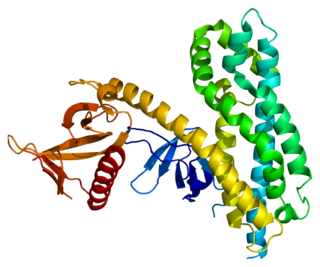
Trpc4-associated protein is a protein that in humans is encoded by the TRPC4AP gene.

ARF GTPase-activating protein GIT2 is an enzyme that in humans is encoded by the GIT2 gene.

Mitochondrial Rho GTPase 1 (MIRO1) is an enzyme that in humans is encoded by the RHOT1 gene on chromosome 17. As a Miro protein isoform, the protein facilitates mitochondrial transport by attaching the mitochondria to the motor/adaptor complex. Through its key role in mitochondrial transport, RHOT1 is involved in mitochondrial homeostasis and apoptosis, as well as Parkinson’s disease (PD) and cancer.

Lysine-specific demethylase 4C is an enzyme that in humans is encoded by the KDM4C gene.

TBC1 domain family member 10A is a protein that in humans is encoded by the TBC1D10A gene.

Rho-related BTB domain-containing protein 3 is a protein that in humans is encoded by the RHOBTB3 gene.

StAR-related lipid transfer domain protein 13 (STARD13) also known as deleted in liver cancer 2 protein (DLC-2) is a protein that in humans is encoded by the STARD13 gene and a member of the DLC family of proteins.

RING finger protein 10 is a protein that in humans is encoded by the RNF10 gene.

Ninein-like protein is a protein that in humans is encoded by the NINL gene. It is part of the centrosome.

Rho guanine nucleotide exchange factor 4 is a protein that in humans is encoded by the ARHGEF4 gene.

DCC-interacting protein 13-beta is a protein that in humans is encoded by the APPL2 gene.

Twinfilin-1 is a protein that in humans is encoded by the TWF1 gene. This gene encodes twinfilin, an actin monomer-binding protein conserved from yeast to mammals. Studies of the mouse counterpart suggest that this protein may be an actin monomer-binding protein, and its localization to cortical G-actin-rich structures may be regulated by the small GTPase RAC1.

FERM, RhoGEF and pleckstrin domain-containing protein 2 is a protein that in humans is encoded by the FARP2 gene.

HMG box transcription factor BBX also known as bobby sox homolog or HMG box-containing protein 2 is a protein that in humans is encoded by the BBX gene.

Putative sodium-coupled neutral amino acid transporter 10, also known as solute carrier family 38 member 10, is a protein that in humans is encoded by the SLC38A10 gene.

Protein FAM134C is a protein that in humans is encoded by the FAM134C gene.

CSRP2 binding protein is a protein that in humans is encoded by the CSRP2BP gene.

Mitochondrial methionyl-tRNA formyltransferase is a protein that in humans is encoded by the MTFMT gene.

Tubulin tyrosine ligase-like family, member 3 is a protein that in humans is encoded by the TTLL3 gene.
Rho GTPase activating protein 18 is a protein that in humans is encoded by the ARHGAP18 gene. The gene is also known as MacGAP and bA307O14.2. ARHGAP18 belongs to a family of Rho GTPase-activating proteins that modulate cell signaling.















